The pale shades of dawn spread gently upwards from the eastern horizon. The rest of the sky is still a dark indigo sprinkled with stars. Slowly, dim shapes emerge from the gently undulating land, like actors on a darkened stage waiting for the lights to come on. Lone thorny trees stand like shadowy sentinels, each carefully guarding its patch of dry earth. One can make out the tangled thickets of kair bushes with their delicate, angled stems, right next to the curving stalks of the akra bush with their soft large leaves. Clumps of kheemp bushes cling to the sand slopes, while the sturdy, prickly ranks of the thhor cactus stand ready to face the blaze of day. Then comes the sun, like a slow-moving impresario, revealing a vast, dramatic stage of land and sky. Tufts of wild grass sparkle gold, as angled sunlight dances off the dew on their stalks. Alongside are the silvery lines of soft white bui, the desert cotton plant.
Birds twitter in appreciation of the dawn, deer emerge furtively from the scrub, and, above, against the brightening canvas of the sky, eagles, harriers and hawks wheel and circle looking for the first morsels of the morning. Another day has begun in the desert, that vast expanse of stunning contrast and enduring beauty, where survival is both a matter of daily effort and exultation.

The tangled branches of a kair thicket are outlined against a pale sky lit with dawn colours

Deer emerge from the undergrowth

Dewdrops on wild grass

Clumps of wild grass and desert cotton spread out in waves along the edges of the sandy dunes
The Arna Jharna museum is located in the Thar bioregion that extends from the edge of the Aravallis in the east into the provinces of Punjab, Sindh and Pakhtunwala in Pakistan, and down to north Gujarat. It is an arid climatic zone characterised by sandy soil, a rocky sub-stratum and scarce water resources. A dry, desert breeze blows incessantly, and leads to shifting sand dunes and sand sheets that cover arable lands and grazing pastures. The soil varies in depth, nutrient value and its capacity to retain water. Rainfall is limited, and groundwater tends towards salinity and excessive mineralisation.
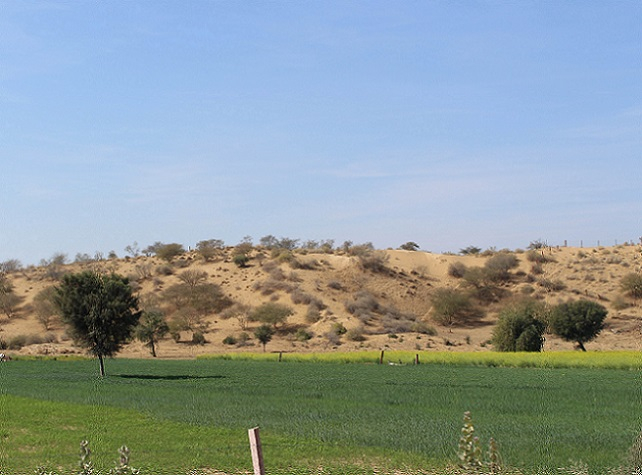
Sand dunes bordering irrigated, arable fields
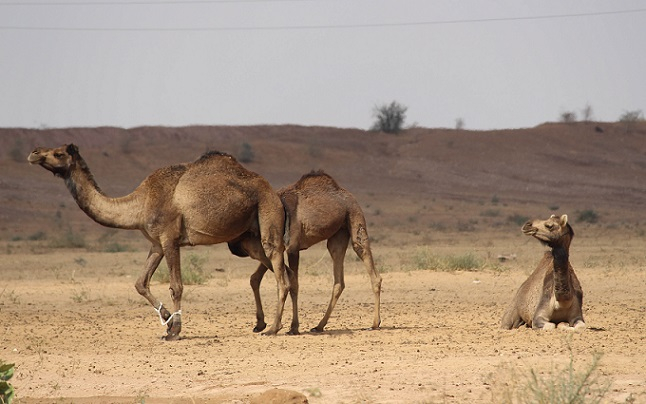
Camels belonging to a pastoral herding community
Yet, despite the difficult terrain, the desert does bloom, and a wide variety of hardy plants comprise a vegetative zone called the North-western Thorn Scrub Forest consisting of perennial and annual grasses, shrubs and small trees. At various times of the year, particularly the short rainy season, the brown and green landscape is enlivened by bursts of bright white, pink, orange, red and yellow as the various plant species come into flower and fruit.
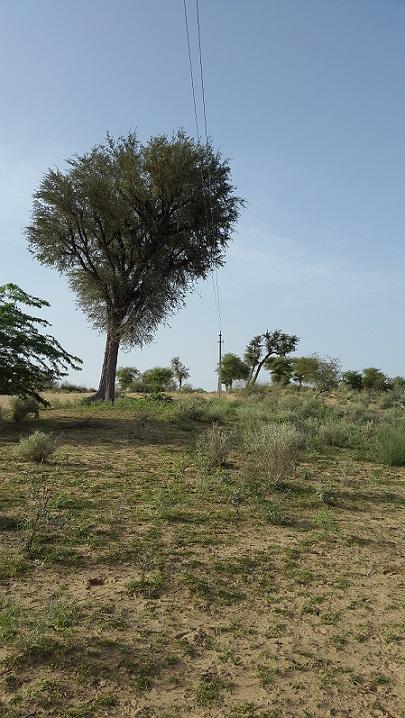
The monsoon rains create a carpet of green on the sandy soil
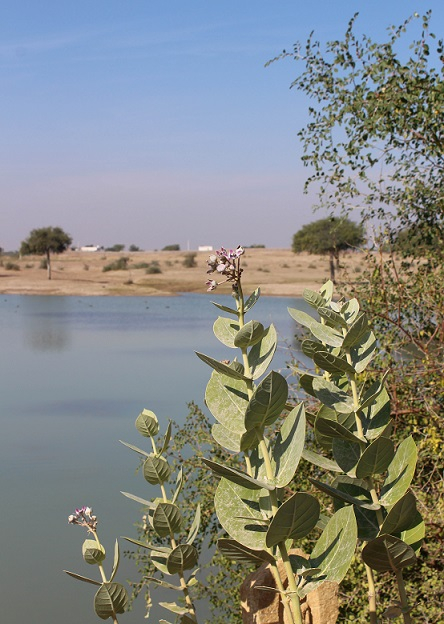
The brief monsoon fills up small ponds and lakes in the region
Plant adaptations
Low rainfall, intense sunlight and dry winds have led to numerous xerophytic plant adaptations. The simplest adjustment is to have a shorter lifecycle, which is found in the desert ephemerals that germinate in the first rains in July and die out by the time the soil dries up by December, leaving behind seeds that will bloom again next year.
The native plant species have adaptations that enable them to reproduce, grow and survive in the most inhospitable edaphoclimatic conditions. Some plants have evolved special root systems, while other have unique leaf characteristics that allow them to withstand prolonged periods of drought. Many woody species simply lose their leaves when soil moisture conditions become too dry. In general, the plant species of arid zones have xeromorphological leaf structures, physiological control of transpiration and metabolism, moisture and nutrient storage organs, and thorns (Sharma and Tewari 2016:4).
Plants lose water vapour as transpiration through leaves. To reduce the surface area of leaves, xerophytic plants such as the kumatiyo (Acacia senegal), ber (Zizyphus mauritiana), and googal (Commiphora wightii) have fewer branches, smaller leaves and thorns/spines. The kair bush (Capparis decidua) has new leaves for less than a month around March and usually exists as an untidy thicket of leafless twigs. Some plants have fine hair on the surface of leaves to break the airflow or a wax coating on the leaf surface to reflect sunlight. Both these adaptations can be seen in aak (Caliotropis procera), a common shrub that also acts as a sand binder on the dunes. Succulents like cactus are able to store water in its tissues. Thhor is the most visible cactus of this region that grows in a widening circle, providing, within its stalks, a protected, shady microhabitat for other plants. Species such as the khejri tree (Prosopis cineraria) and the kair shrub (Capparis decidua) have a deep root system to tap into ground water reserves.
An Endangered Fauna
The fauna of arid regions are similarly adapted to the extreme conditions. In addition, the gradual lessening of grassland/forest cover has added another dimension to the struggle for survival. The prevalent wildlife includes the leopard, the Asiatic wild cat (Felis silvestris ornata), the chinkara (Gazella bennettii), the chousingha (Tetracerus quadricornis), blackbuck (Antilope cervicapra), the Bengal desert fox (Vulpes bengalensis) and various reptiles. Of the 68 species, 29 species are listed in the Indian Wildlife (Protection) Act, requiring varying degrees of protection. The desert cats feed on deer, rodents, rabbits and lizards. The perennial grasses and thorny shrubs provide fodder for chinkara as well as the livestock herds of local communities.
There are over 141 species of migratory and resident birds in the Thar region. The critically endangered great Indian bustard (Ardeotis nigriceps), historically used to be distributed across 11 Indian states and even Pakistan but the grassland patches of the Thar are now their last remaining stronghold with less than 500 pairs at the last count in 2016. The vulnerable McQueen’s bustard (Chlamydotis mcqueenii) and the mysterious lesser florican (Eupodotis indica) keep it company.
The Thar is also home to many varieties of raptors. These include the critically endangered red-headed vulture (Sarcogyps calvus), white-rumped vulture (Gyps bengalensis) and Indian vulture (Gyps indicus). Other scarce or near threatened species of raptors are the steppe eagle (Aquila nipalensis), imperial eagle (Aquila heliaca), pallid harrier (Circus macrourus), laggar falcon (Falco juggar), and the short-toed (Circaetus gallicus), tawny (Aquila rapax) and spotted eagles (Aquila clanga).
Several species of larks, finches, wheatears and tits can be found in the region. While the rufous-tailed lark (Ammomanes phoenicura) is an endemic lark, the trumpeter finch (Bucanetes githagineus) and greater hoopoe-lark (Alaemon alaudipes) often travel in from neighbouring Pakistan. Cream-coloured courser (Cursorius cursor) and chestnut-bellied sandgrouses (Pterocles exustus) often go unnoticed as they blend into the sandy-coloured landscape.
Arna Jharna is located by an abandoned sandstone mine. Water harvesting and careful soil management has transformed the site into a well-watered site, with a rich cover of indigenous, resilient desert flora, an ideal nesting ground for the numerous birds of the area. Come dusk, the harsh calls of the mor or Indian peafowl contrast with the softer tones of the tidodi (lapwing) and the kamedi (collared dove). Also to be heard is the insistent call of the titars and the excited chirping of sparrows. Also to be seen are the bulbul (peencho), kites (cheel) and crows (kagla).

Egyptian vulture (photo by Vineeta Dixit)
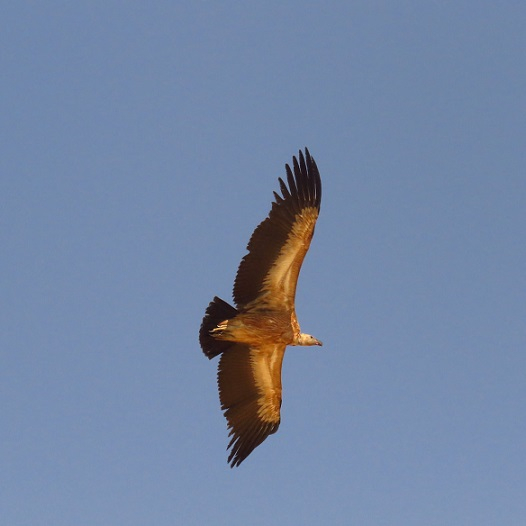
Indian vulture (photo by Vineeta Dixit)

White-rumped vulture (photo by Vineeta Dixit)
White-cheeked bulbul (photo by Vineeta Dixit)
Ecology and culture
In his tome on Rajputana, James Tod described the origin of a popular Mewari saying, ‘anwal, anwal Mewar, bawal, bawal Marwar’ which makes plants the basis for territorial divide between the frequently feuding states. An envoy of Maharana Bheem Singh of Mewar explained to Tod, ‘Wherever the anwal [Cassia aurigulata] puts forth its yellow blossom, the land is of right ours . . . Let the Marwaris enjoy their stunted babuls (Acacia nilotica), their karil (Capparis decidua) and the ak (Caliotropis procera) but give us back our sacred pipal (Ficus religiosa) and the anwal of the border’ (Tod 1920:803). Though not strictly accurate, this commonly held belief links regional identity, flora and history (Hughes 2013:103–04).
The ecological biodiversity of Thar is closely linked to the daily life of the people and forms the basis for traditional knowledge systems. A study of the perennials of the region states:
Nowhere in the world are they so intricately associated with the life of human beings as in arid areas. To evade or minimize the adverse effects of frequent droughts, the native peoples in arid zones have often developed production systems in which woody perennials have a very important role, both from productivity as well as a resource conservation point of view. Their centuries-old experiences, under diverse socioeconomic and cultural conditions, were passed from generation to generation and have established well-contained systems of production (agropastoral/livestock husbandry) which accrue maximum benefits from their woody component(s) (Sharma and Tewari 2016:5).
The Bishnoi tribe practice a form of ‘ecoreligion’ that holds all life forms including trees to be sacred, and go to great lengths to conserve the ecology of their area. The story of the courageous Amrita Devi Bishnoi is legendary, and seen as a precursor of the later Chipko movement.
She sacrificed her life and led by example to protect the khejri tree. In 1778, 294 Bishnoi men and 69 women sacrificed their lives to protect trees led by the example of Amrita Devi. When officials of the Jodhpur state arrived to cut the trees in her Bishnoi village for wood, she hugged the first khejri tree and literally came between the tree and the woodcutter’s axe. Her three daughters followed suit, followed by the other Bishnois. ‘This mass slaughter led to a royal order that prohibited the cutting of any tree in a Bishnoi village’ (Thapar 1997:179).
A temple at Khejarli marks the site of the massacre and every year thousands of Bishnoi congregate to commemorate the sacrifice of their ancestors. As a community they have taken on the challenge of preventing animal poaching. There is even a vigilante group called the Bishnoi Tiger Force patrolling the Jodhpur district[1].
A Bishnoi couple: the Bishnois believe all life—plant and animal—to be sacred. Photo by Vineeta Dixit.
A report in Journal of Plant Chemistry and Ecophysiology states:
Rural people in India are endowed with a deep knowledge concerning the use of alternative plants when the staple food is in short supply and alternative food consumption is still very common in rural areas in Rajasthan.
There are about 30 plant species in arid zone known for their edible use and of these about 20 plant species are known for their edible fruits either raw or use as vegetable (Tewari 2016:1).
Traditionally, the tribal communities of Rajasthan are pastoralists. The varied grasses, shrubs and low branches of trees provide fodder for sheep, camels and cattle. Generations of lore and logic have distilled a bank of knowledge on the medicinal properties of arid plant species, which is now being used for commercial ayurvedic preparations too. In times of crop scarcity, fruit, roots and seeds of wild plants supplement the diet. Listed below a few useful species (for further details of the significance and uses of different desert trees, shrubs and grasses, see the Photo Essay on the Plants of the Thar):
Khejri (Prosopis cineraria): Vital to the ecology with its deep root system penetrating up to 30 metres, it provides both fodder and food. Its pods are gathered when green and cooked as a vegetable. The timber is used for houses, carts and furniture. It offers numerous medical applications to treat asthma, leucoderma and leprosy. Its flowers are pounded, mixed with sugars and eaten by pregnant women to safeguard against miscarriage. The grounded inflorescence mixed with sugar in water is used for prevention of boils and skin diseases. The dried bark and its paste are used to cure rheumatism.
Rohira (Tecomela undulata): Bark paste is applied to cure eczema and syphilis. The powder of root bark is used as a cure for leucorrhoea and diabetes. The timber is highly regarded and used for furniture, printing blocks and implements.
Ber (Ziziphius mauritania): The tangy-sweet fruit is rich in Vitamin C. It is eaten raw, or dried, powdered and mixed with molasses or bajra flour. The flowers yield honey. The leaves provide fodder, and the root, bark and fruit are used in traditional medicine to treat inflammation, rheumatism and digestive ailments. The orange resin deposited on the leaves by the lac insect is used to make shellac. The bark and wood also yield a cinnamon-coloured dye and tanning material. The wood is hardy and used for farm implements and beams. It also makes good charcoal and fuel wood.
Badh (Ficus benghalensis): All parts of this venerable tree have varied medicinal uses. Its latex is used to treat rheumatic pains, the leaves cure abscesses and root fibres are used to treat gonorrhoea. Infusions of the bark serve as a tonic, and bark paste with pepper is used against snakebites. Monkeys, birds and bats relish the fruit, and the leaves are excellent fodder for large animals. Though not native to arid regions, it has been widely naturalised; Hindus worship it as the consort of the pipal.
Kair (Capparis decidua): The fruit and flowers are cooked as a vegetable, usually with khejri pods. Stems and new leaves are ground and the paste is applied to cure boils and swellings. Paste of coal from wood is applied externally to muscular injuries. Powdered root bark is taken with hot water to cure asthma and cough, and as a laxative.
(All photos in this article are taken by the author.)
Guide to Further Reading
Austa, Sanjoy. 2015. 'Ranaram Bishnoi, the 75-year-old who stopped the March of the Desert', YourStory April 25. Online at https://yourstory.com/2015/04/ranaram-bishnoi/ (viewed on September 18, 2017).
Hughes, Julie E. 2013. Animal Kingdoms. Harvard: Harvard University Press.
Kapoor, B.B.S., and Swati Lakhera. 2013. ‘Ethnomedicinal Plants of Jodhpur District, Rajasthan Used in Herbal and Folk Remedies,’ Indian Journal of Pharmaceutical and Biological Research (IJPBR) 1.4: 71–75. Online at http://citeseerx.ist.psu.edu/viewdoc/download?doi=10.1.1.403.6008&rep=rep1&type=pdf (viewed on September 18, 2017).
Krishen, Pradip. 2011. The Small Plant Guide to Rao Jodha Desert Rock Park. Jodhpur: Mehrangarh Museum Trust.
———. 2013. Jungle Trees of Central India. Delhi: Penguin Books.
Ram, Sonu, Arun Vats, and Ajay Kumar Sharma. 2016. ‘Ethno-Medicinal Uses of Some plants of Suratgarh Tehsil, Sriganganagar (Rajasthan),’ International Journal of Applied Research.
Rajasthan State Biodiversity Board. 'Threatened Species of Rajasthan'. Online at http://environment.rajasthan.gov.in/content/environment/en/rajasthan-state-biodiversity-board/about-rajasthan/threatened-species-of-rajasthan.html(viewed on September 18, 2017).
Sharma, Arun K., and J.C. Tewari. 2016. ‘Arid Zone Forestry with Special Reference to Indian Hot Arid Zone’, in Encyclopaedia of Life Support Systems, Vol. II: Forests And Forest Plants. Jodhpur: Central Arid Zone Research Institute.
Sharma, K.K. and S.P. Mehra. 'The Thar of Rajasthan (India): Ecology and Conservation of a Desert Ecosystem', in Faunal Ecology and Conservation of the Great Indian Desert, eds. C. Sivaperuman et al. Heidelberg: Springer Verlag. Online at http://www.springer.com/cda/content/document/cda_downloaddocument/9783540874089-c1.pdf?SGWID=0-0-45-656808-p173843214 (viewed on September 18, 2017).
Sharma, Meghendra and Ashwani Kumar. 2013. 'Ethnobotanical Uses of Medicinal Plants: A Review', International Journal of Life Science and Pharma Research 3.2:52–57. Online at http://docplayer.net/38487969-Ethnobotanical-uses-of-medicinal-plants-a-review-abstract.html (viewed on September 18, 2017).
Tewari, V.P. 2016. ‘Some Important Fruit Trees and Shrubs of Hot Arid Regions of Rajasthan State in India: Their Uses and Nutritive Values,’ Journal of Plant Chemistry and Ecophysiology 1.1:1–5. Online at http://austinpublishinggroup.com/jpceonline/download.php?file=fulltext/jpce-v1-id1004.pdf (viewed on September 18, 2017).
Thapar, Valmik. 1997. The Land of the Tiger: A Natural History of the Subcontinent. Berkeley: University of California Press.
Tod, James. 1920. Annals and Antiquities of Rajasthan, or the Central and Western States of India. 2 vols, ed. William Crooke. Oxford: Oxford University Press.
Online Resources
E-Flora of Gandhinagar. Online at http://www.efloraofgandhinagar.in/herb/aerva-sanguinolenta (viewed on September 18, 2017).
Flowers of India. Online at http://www.flowersofindia.net (viewed on September 18, 2017).
Grassland Index. Online at http://www.fao.org/ag/agp/agpc/doc/gbase/latinsearch.htm (viewed on September 18, 2017).
Hortipedia: The GardenInfo Portal. Online at http://en.hortipedia.com/wiki/Main_Page (viewed on September 18, 2017).
Landmark Trees of India. 2017. Online at https://outreachecology.com/landmark/overview/outreach/ (viewed on September 18, 2017).
The Plant List. 2010. Version 1. Online at http://www.theplantlist.org/ (viewed on September 18, 2017).












